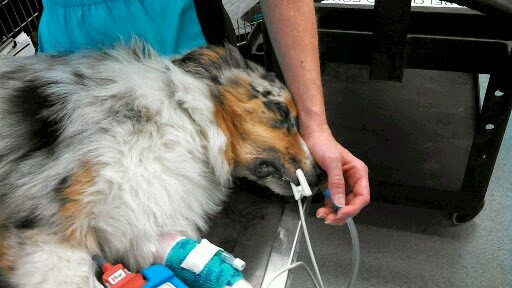nasal_o2.jpg - Caption. [Optional]
![nasal_o2.jpg - Caption. [Optional] A photo image of a dog with a nasal tube](/AppUtil/Image/handler.ashx?imgid=8887442)
Image of a sedated dog with nasal oxygen lines placed. Different methods can be used to secure the lines. Image courtesy Tony Johnson, DVM, DACVECC
Not being able to catch your breath (shortness of breath, or dyspnea) is a terrible feeling. It can feel like drowning, and pets who are short of breath experience the same thing as people do.
Some reasons why your pet may experience dyspnea include:
- Pneumonia
- Heart disease
- Fluid in the lungs (pulmonary edema)
- Fluid in the chest (pleural effusion)
- Heartworm disease
- Asthma
- Laryngeal paralysis
- Trauma (pulmonary contusions)
- Collapsed lung (pneumothorax)
- Heat stroke
- Drug overdose/toxins
- Spinal cord/brain disease or trauma
If your veterinarian has determined that your pet needs oxygen therapy (either through physical examination or with the help of instruments that measure oxygen levels), there are several ways that it can be delivered. The chosen method depends on many factors, such as:
- Species, temperament, size, and breed of your pet
- Availability at your veterinarian’s facility
- Need for oxygen at home
- Length of expected oxygen treatment
- Cost
- Severity of dyspnea/primary disease
For very severely dyspneic patients, a breathing tube may need to be placed (usually under sedation), and either staff or a machine may need to breathe for your pet. If a person is helping your pet breathe, this is called manual ventilation; if a machine is breathing for your pet, this is called mechanical ventilation.
img_20130811_101656_505__1_.jpg - Caption. [Optional]
![img_20130811_101656_505__1_.jpg - Caption. [Optional] Photo image of a dog on a hospital bed receiving a breathing treatment](/AppUtil/Image/handler.ashx?imgid=8887457)
Image of an Australian Shepherd with ivermectin toxicity on a mechanical ventilator. Image courtesy Tony Johnson, DVM, DACVECC
Here are the main methods for delivering oxygen to dyspneic patients, with some notes on each.
1. Flow-by oxygen: This is the simplest method of giving oxygen and is often started in the ER when a patient with dyspnea arrives. The oxygen supply tube is placed in front of the patient (sometimes with a clear plastic bell to direct the oxygen into the nose and mouth). It is not for long-term use.
2. Oxygen cage: This is essentially a large box with oxygen piped into it. More advanced cages can regulate carbon dioxide, oxygen levels, and temperature (to avoid overheating and help warm up hypothermic patients). This is similar to an oxygen tent used for people. Sometimes, a mini oxygen cage can be made for an individual patient by placing a cone collar on them, covering the front partially with clear plastic wrap, and feeding an oxygen tube into the base.
Room air (what we are all breathing right now, unless you are on Mt. Everest) is 21% oxygen. Usually, oxygen cages are set at about 40% oxygen, doubling the patient's amount of oxygen. Higher percentages are not used (unless needed) because oxygen levels greater than 40% can become toxic over time. Patients can breathe 100% oxygen, but the risk of oxygen toxicity is greater after 24 hours on 100% oxygen. Oxygen can be very drying on the delicate nasal tissues, so usually humidified oxygen (regardless of the means used to deliver it) is provided.
Oxygen cages are best suited for cats and small dogs. Cats often prefer the isolation an oxygen cage provides, as the cage tends to shield the stressed cat from the sounds of a busy ICU. Larger dogs (more than approximately 20 lbs or 10kg) often need a different means of oxygen delivery, as they can overheat in the relatively small cage.
1375888583817.jpg - Caption. [Optional]

Image of a patient receiving flow-by oxygen before being mechanically ventilated. Image courtesy Tony Johnson, DVM, DACVECC
3. Nasal oxygen: For larger dogs (and occasionally cats and small dogs), nasal oxygen works very well and allows them to be out in the open so that they can be monitored, and care can be given. This is similar to the oxygen prongs that people use, but the prongs used in people are often too short to be used in dogs. One or two soft rubber tubes are gently inserted a few inches into the nose, usually under local anesthesia or light sedation. Nasal oxygen lines are generally well-tolerated but are sometimes sneezed out. Usually, an Elizabethan collar (cone collar) is needed to prevent the patient from removing the tubes.
For snub-nosed breeds (brachycephalic) like bulldogs and pugs, the tube can be fed from the nose into the back of the throat or windpipe. These are known as nasopharyngeal oxygen and nasotracheal oxygen, respectively.
For patients with more severe dyspnea, a different version of nasal oxygen, known as high-flow oxygen therapy, can be used. This requires a special machine, which is not currently widely available but is becoming more popular.
4. Intubation: This is used for patients with severe dyspnea or unconsciousness and involves placing a breathing tube into the windpipe to provide oxygen and help breathing. This requires sedation, unless the patient is not conscious. Most intubated patients are not breathing on their own and must either be manually or mechanically ventilated.
Mechanical ventilation (often called “life support”) is one of the most intensive and complex therapies a pet can receive. It requires constant, vigilant attention and monitoring, and 24-hour care.
Final Notes
Once placed on oxygen, your pet will be monitored closely for signs of improvement or worsening. This may involve noting whether breathing is improving or using instruments that measure how much oxygen or carbon dioxide is in the blood (pulse oximeter, blood gas analysis, or capnography).
Once your pet's breathing improves, oxygen can be tapered off until they can breathe room air again, usually over 12 to 24 hours. Some patients can be weaned off oxygen, but they may tire from the effort and have to be placed on oxygen again.
Home oxygen for pets is available and is increasing in use. In general, pet care at home is not as advanced as for people. Still, more and more companies are providing pets with access to oxygen at home, usually through a machine called an oxygen generator.
If your pet needs oxygen (whether in the hospital or at home), talk to your veterinarian about options, prognosis, and cost. Oxygen therapy can be life-saving for pets, and for pets with dyspnea, it can help them feel more comfortable as they heal.
img_20130821_092900_277.jpg - Caption. [Optional]

The patient made a complete recovery from ivermectin toxicity due to the ventilator. Image courtesy Tony Johnson, DVM, DACVECC